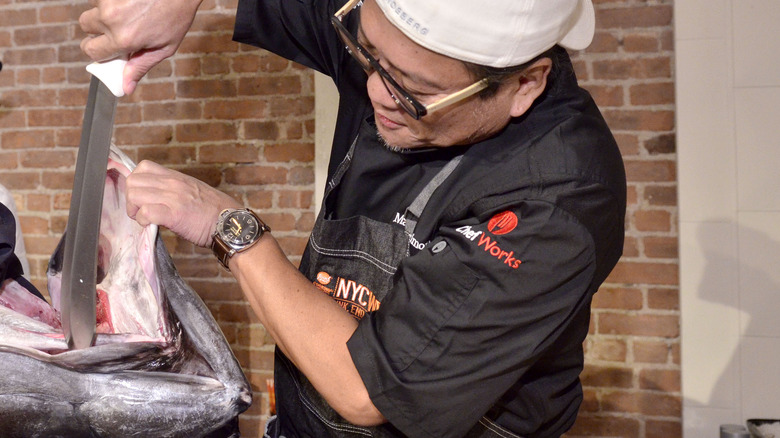The Tuna Red Flags You'll Never Un-See, According To Chef Morimoto - Exclusive
Whether sesame-seared tuna, tuna poke, or Tekka Maki rolls are on your mind, know this: fresh tuna can go from the foodstuff of the deities to fit for ants in seconds. It's a defense mechanism that the saltwater fish is born with, which, if not handled correctly, may ruin your dinner plans, Iron Chef Masaharu Morimoto warned us in a recent exclusive interview. "When they're hooked, they burn, like meat, because of their own temperature, from the inside out," he explained. It's a phenomenon called "yake" in Japanese, or "burnt flesh syndrome," and if the meat isn't treated by the fishermen properly, it leads to the rapid degradation of the fish's muscles and sub-par, metallic flavors.
Tuna that have succumbed to this will likely be brown or "darker blood-colored," Chef Morimoto told us. That's a huge red flag that the celebrity chef said we should watch out for, even when working with frozen tuna. That's because fishermen, Morimoto explained, must "put [tuna] in ice water immediately" to lower their temperature. You can tell if the fish was "left out a long time," per Morimoto, if — upon defrosting — the fish starts "changing color" from red to darker colors.
Oh, and also? "Beware of smell," Morimoto told us. Fresh tuna shouldn't smell like rotten fish. If you spot either of those two red flags, perhaps it's best to swap out your Tekka Maki plans for something less fishy. If not, it's tuna roll time!
If your tuna is fresh, try rolling it into sushi
If Chef Morimoto had his way (as he recently told Eater), we'd all be having sushi-rolling parties as often as we host backyard barbecues. Assuming the tuna you've picked out shows no signs of burning or exceptionally fishy smells, why not try a Tekka Maki roll? The simple combination of tuna, rice, and seaweed also happens to be the first roll Chef Morimoto orders when walking into a sushi restaurant, per what he recently dished to Mashed.
Be patient, and don't expect to copy the speed and precision of the professionals at your favorite sushi joint, Morimoto says. "You should buy seaweed, you should cook the rice, and then what we'll need is seasoning, like vinegar and soy sauce and sugar," the sushi master explained. "Don't even think about it so much. Seaweed, rice roll, then do it one by one." It's okay if friends and family enjoy sushi "little by little" instead of all at once. You can make it into a game, Morimoto says. Set sushi goals, such as, "Last time I spent five minutes rolling sushi; let's do it in three minutes this time," the chef suggested. However long it takes, enjoy the process, and know you can at least be confident in the important part — picking fresh ingredients.
Pick up more sushi tips from Chef Morimoto on Chef Morimoto's "Sushi Master," which you can stream for free on The Roku Channel.

